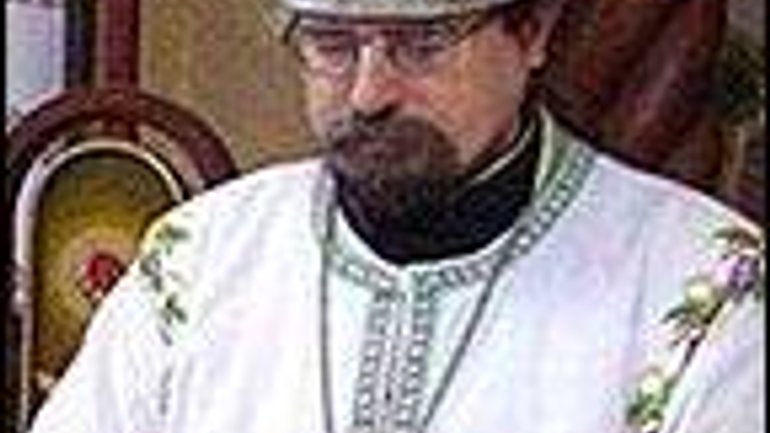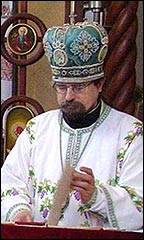"Today ecclesiastical prospects demand from us the gradual development into a single national church"

 An interview with Archbishop IHOR (Isichenko) of Kharkiv and Poltava of the Ukrainian Autocephalous Orthodox Church
An interview with Archbishop IHOR (Isichenko) of Kharkiv and Poltava of the Ukrainian Autocephalous Orthodox Church
— The Kharkiv-Poltava Eparchy of the Ukrainian Autocephalous Orthodox Church (UAOC) has officially changed its juridical status. What is the essence of the change? What consequences might this have?
— Being convinced that continuation of the canonical life of the UAOC was not possible, the eparchial sobor [assembly] of the Kharkiv-Poltava Eparchy on 11 April 2003 approved its own statutes, which foresee the further activities of the eparchy on the foundations of the act of 27 July 1942 in union with the UAOC in the diaspora and independent of other religious unions that arose in Ukraine from 1943 to 2003. By the way, the decision to work on separate eparchial statutes was approved already at the first sobor after the legalization of the eparchy, on 5 April 1992.
When it became clear that the government would not recognize the eparchy under its own name, we made concessions and added to the name the word “Renewed,” proposed by the State Department on Religious Matters. In the internal life of the eparchy, in church documents, this comedic addition, understandably, is not being used.
On 29 March 2006 the eparchial statutes were registered. Then the new statutes of the eparchial consistory were registered. This allowed the creation in our government of a legal field for the activities of these church communities and institutions which maintained faithfulness to the testament of Patriarch Dymytrii [Yarema] and the decisions of the National Sobor of 2000, which did not enter into schism with our church in the diaspora and continue to acknowledge itself as the same UAOC with eparchies in Western Europe, South America, and Australia.
Looking at the current status of the eparchies abroad, which after 1995 belonged to the Patriarchate of Constantinople, our relations have their own legal problems, but the sobors of the Kharkiv-Poltava Eparchy from 2000 to 2006 more than once expressed their readiness to overcome juridical collisions only in strict adherence to the decrees of canonical church authorities. Again in 2000 I swore before the sobor that, in case of necessity, at the order of the canonical authorities I would take the obligations of eparchial hierarch. These obligations, by the way, are not simple.
— In a recent interview Metropolitan Mefodii (Kudriakov), head of the UOAC, said that, by changing its name, the Kharkiv eparchy has separated itself from the UAOC of patriarchs Mstyslav and Dymytrii. What is your response to this statement?
— Mefodii, Mefodii… But who is this? Remind me, please… I never heard that under Patriarch Mystyslav or Patriarch Dymytrii such a clergyman was ordained in the UAOC. And I do not think it worthwhile to give attention to the bad expressions of various marginal [figures].
— How do you assess the internal status of the UAOC today? Are there already parishes that want to join your eparchy after the changes in its statutes?
— The eparchy unites those communities that do not want to take part in the various types of schismatic groupings that call themselves part of the UAOC which operated in Ukraine from 1942 to 1944 and then from 1942 existed outside the territory of Ukraine. They accept the higher spiritual leadership of UAOC Metropolitan Constantine [head of the Ukrainian Orthodox Church of the USA] and are ready to submit to real canonical discipline. There are no more than 30 such parishes, and the affiliation of new communities happens very carefully. In 2003 we accepted into the eparchy new communities on the territory where the Kharkiv-Poltava Eparchy functioned in 1942-43. The UAOC appeared later in Halychyna [far western Ukraine], only in 1989, and has no historic roots and, because of this, it is going through a dramatic search for its own identity. We, eastern Ukrainians, can provide little help in this. So I would ask the parishes of Halychyna at present to refrain from appeals to our eparchy and to try to normalize the church life in their own place, and then, together, to enter into dialogue. By the way, the Lviv Eparchy in 2005-2006 did quite a bit in this regard. I think that the registration of our eparchial statutes will open better prospects for the dialogue of the Kharkiv-Poltava and Halychyna eparchies, and in the course of development one can hope for the preparation of a new national sobor of the UAOC.
— Do you think there are many people in the UAOC who support the idea of uniting with the Ukrainian Orthodox Church-Moscow Patriarchate (UOC-MP)?
— To tell the truth, I have not met such people. It is possible that among those eternally wandering between jurisdictions in search of gain there are some vagrants who count on acquiring a comfortable place in the Moscow Patriarchate. But for parishioners, in Halychyna and in the east of Ukraine, joining the UAOC was always a conscious and responsible choice. They can dismiss a priest, but they themselves will never go to the Moscow Patriarchate. And this is already a problem for the UOC-MP: Do they need “homeless” clergy with questionable reputations?
— Back in 1997 you developed an idea/plan for the Ukrainian church to receive the canonical status of autocephaly. How realistic is this plan today?
—Unfortunately it does not look any more realistic today than in 1997. However, in view of canon law and maintaining the consistency of the Kyivan national tradition, it remains the only realistic proposal. I have not heard about others. The idea of uniting the UAOC with the UOC-KP [Ukrainian Orthodox Church-Kyivan Patriarchate] with the probable (!) further recognition of this union by Constantinople or joining the UAOC to the UOC-MP on unknown bases (through repentance?) with a dim prospect of receiving autonomy from Moscow in the future look not-thought-out and utopian.
— If you compare the status of the UAOC at the end of last century and today’s status, when did it stand closer to canonical recognition?
—Prospects for the canonical recognition of illegitimate religious groups that left obedience to Metropolitan Constantine in 2003 and in connivance with the secular powers illegally took for themselves the name “UAOC” today do not exist. Thanks to Patriarch Dymytrii, his trips to the USA and testament, prospects for the recognition of the authentic UAOC were opened for a short time in the year of the great jubilee. I believe that the will of divine providence was revealed in this. However, the prospects were lost. And the only hope today is on the boundless grace of God, which is able again and again to forgive us and give a new chance.
But let us ponder soberly: Would there be any use in the canonical recognition by the mother-church of one of the Orthodox jurisdictions in Ukraine, the smallest and the most divided? Would this bring the creation of a single national church closer? The main thing is: What would this church then become? Today ecclesiastical prospects demand from us the gradual development into a single national church. For the Ukrainian divisions of the UAOC there is now one historical chance: to enter into the church structure that is being formed in the world under the mantle of the ecumenical patriarch [of Constantinople], on the foundation of separate eparchies subordinated to a single metropolitan and with a single permanent conference of Ukrainian Orthodox bishops. The diseases of separatism which, not without the help of foreign religious and non-religious organizations, burst out among the UAOC episcopate in 2003 appear as obstacles on this road.
— How would you describe the prospects for the development of the UAOC in the nearest future?
—The prospects for our eparchy were set already on 30 August 2003 by a special document, “The Kharkiv-Poltava Eparchy: Strategy for the Development of an All-Ukraine Orthodox Sobor.” One can become acquainted with this in a recently-published collection “Canonical Documents of the Kharkiv-Poltava Eparchy of the UAOC” (Kharkiv, 2006). For other eparchies, prospects depend on to what extent they are able to overcome the temptation of social conformism which throughout the last millennium was the greatest threat to the Orthodox church. Today the Lord addresses us, as through Moses He addressed the descendants of Jacob on the road to the promised land: “I have set before you life and death, blessings and curses. Now choose life, so that you and your children may live.” (Deut 30:19) The Apostle Paul eventually interpreted this: “The mind set on the flesh is death, but the mind controlled by the Spirit is life and peace.” (Rome 8:6) “The mind set on the flesh” in church politics puts its hope on the worldly authorities, on the economic clans, on the criminal world, the hidden influence of which on the church is still waiting for its consequences, on the “order of St. Stanislaw,” about the influence of which on the schism in the UAOC has already been written more than once in recent years. Each eparchial community, each assembly faces a test: Is it able to be free of all this? And the UAOC can only acquire prospects [for the future], that is “life and peace,” by liberation from the tenets of the evil “mind set on the flesh.”
Interview conducted by Taras Antoshevskyy, Lviv-Kharkiv, 2 May 2006.









